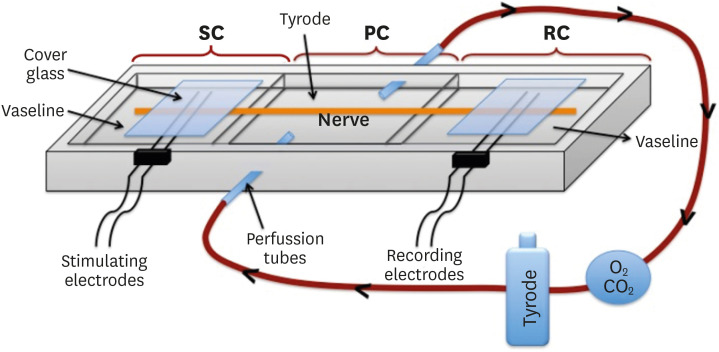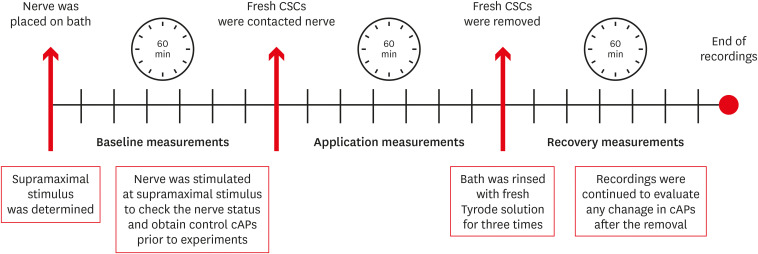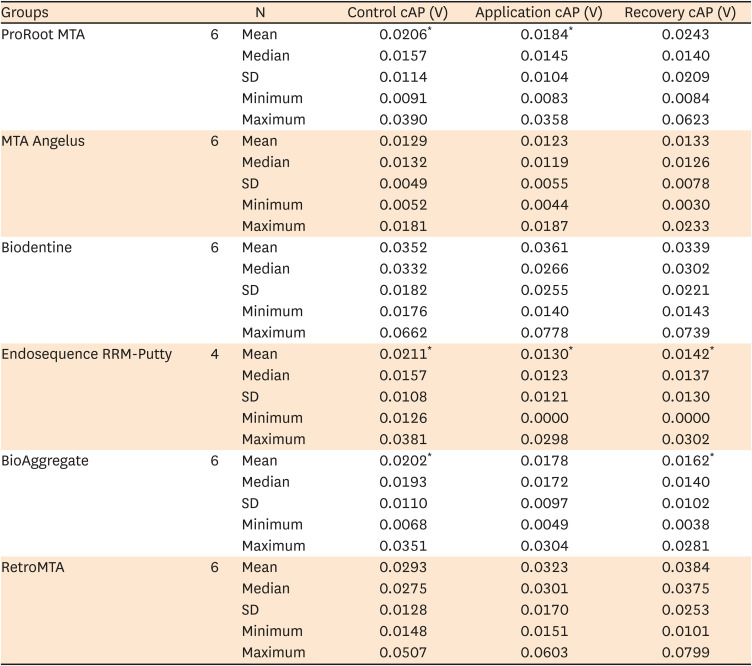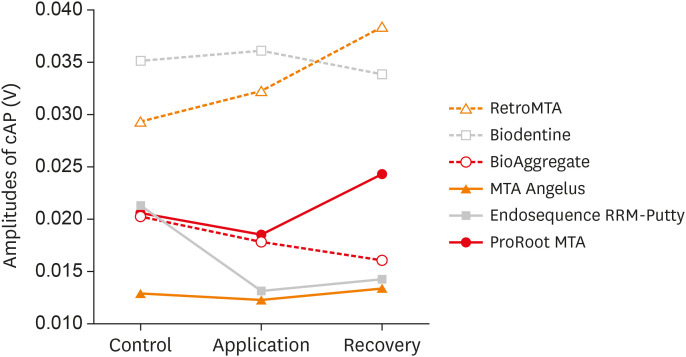1. Dawood AE, Parashos P, Wong RHK, Reynolds EC, Manton DJ. Calcium silicate-based cements: composition, properties, and clinical applications. J Investig Clin Dent. 2017; 8:e12195.
2. Torabinejad M, Hong CU, McDonald F, Pitt Ford TR. Physical and chemical properties of a new root-end filling material. J Endod. 1995; 21:349–353. PMID:
7499973.

3. Parirokh M, Torabinejad M. Mineral trioxide aggregate: a comprehensive literature review--part I: chemical, physical, and antibacterial properties. J Endod. 2010; 36:16–27. PMID:
20003930.

4. Song JS, Mante FK, Romanow WJ, Kim S. Chemical analysis of powder and set forms of Portland cement, gray ProRoot MTA, white ProRoot MTA, and gray MTA-Angelus. Oral Surg Oral Med Oral Pathol Oral Radiol Endod. 2006; 102:809–815. PMID:
17138186.
5. Malkondu Ö, Karapinar Kazandağ M, Kazazoğlu E. A review on biodentine, a contemporary dentine replacement and repair material. BioMed Res Int. 2014; 2014:160951. PMID:
25025034.

6. Roberts HW, Toth JM, Berzins DW, Charlton DG. Mineral trioxide aggregate material use in endodontic treatment: a review of the literature. Dent Mater. 2008; 24:149–164. PMID:
17586038.

7. Walsh RM, Woodmansey KF, Glickman GN, He J. Evaluation of compressive strength of hydraulic silicate-based root-end filling materials. J Endod. 2014; 40:969–972. PMID:
24935545.

8. Kang SH, Shin YS, Lee HS, Kim SO, Shin Y, Jung IY, Song JS. Color changes of teeth after treatment with various mineral trioxide aggregate-based materials: an
ex vivo study. J Endod. 2015; 41:737–741. PMID:
25732402.

9. Torabinejad M, Pitt Ford TR. Root end filling materials: a review. Endod Dent Traumatol. 1996; 12:161–178. PMID:
9028180.

10. Gomes Cornélio AL, Salles LP, Campos da Paz M, Cirelli JA, Guerreiro-Tanomaru JM, Tanomaru Filho M. Cytotoxicity of Portland cement with different radiopacifying agents: a cell death study. J Endod. 2011; 37:203–210. PMID:
21238803.

11. Chang SW, Oh TS, Lee W, Cheung GS, Kim HC. Long-term observation of the mineral trioxide aggregate extrusion into the periapical lesion: a case series. Int J Oral Sci. 2013; 5:54–57. PMID:
23558344.

12. Asgary S, Fayazi S. Endodontic surgery of a symptomatic overfilled MTA apical plug: a histological and clinical case report. Iran Endod J. 2017; 12:376–380. PMID:
28808469.
13. Comin Chiaramonti L, Cavalleri G. Effect of unintentionally extruded mineral trioxide aggregate in treatment of root perforation with periradicular lesion: a case report. Minerva Stomatol. 2011; 60:217–222. PMID:
21471944.
14. Islam I, Chng HK, Yap AU. Comparison of the physical and mechanical properties of MTA and portland cement. J Endod. 2006; 32:193–197. PMID:
16500224.

15. Asgary S, Eghbal MJ, Mehrdad L, Kheirieh S, Nosrat A. Surgical management of a failed internal root resorption treatment: a histological and clinical report. Restor Dent Endod. 2014; 39:137–142. PMID:
24790928.

16. Tuğ Kılkış B, Er K, Taşdemir T, Yildirim M, Taskesen F, Tümkaya L, Kalkan Y, Serper A. Neurotoxicity of various root canal sealers on rat sciatic nerve: an electrophysiologic and histopathologic study. Clin Oral Investig. 2015; 19:2091–2100.

17. Ahlgren FK, Johannessen AC, Hellem S. Displaced calcium hydroxide paste causing inferior alveolar nerve paraesthesia: report of a case. Oral Surg Oral Med Oral Pathol Oral Radiol Endod. 2003; 96:734–737. PMID:
14676765.

18. Pogrel MA. Damage to the inferior alveolar nerve as the result of root canal therapy. J Am Dent Assoc. 2007; 138:65–69. PMID:
17197403.

19. He S, Teagle HFB, Buchman CA. The electrically evoked compound action potential: from laboratory to clinic. Front Neurosci. 2017; 11:339. PMID:
28690494.

20. Onur MA, Cehreli ZC, Tasman F, Gümrükçuoğlu A. Neurotoxic effects of fifth-generation dentin adhesives on rat sciatic nerve. J Endod. 2001; 27:676–678. PMID:
11716079.
21. Damas BA, Wheater MA, Bringas JS, Hoen MM. Cytotoxicity comparison of mineral trioxide aggregates and EndoSequence bioceramic root repair materials. J Endod. 2011; 37:372–375. PMID:
21329824.

22. Asrari M, Lobner D.
In vitro neurotoxic evaluation of root-end-filling materials. J Endod. 2003; 29:743–746. PMID:
14651282.
23. Abbasipour F, Rastqar A, Bakhtiar H, Khalilkhani H, Aeinehchi M, Janahmadi M. The nociceptive and anti-nociceptive effects of white mineral trioxide aggregate. Int Endod J. 2009; 42:794–801. PMID:
19549151.

24. González-Martín M, Torres-Lagares D, Gutiérrez-Pérez JL, Segura-Egea JJ. Inferior alveolar nerve paresthesia after overfilling of endodontic sealer into the mandibular canal. J Endod. 2010; 36:1419–1421. PMID:
20647109.

25. Sarkar NK, Caicedo R, Ritwik P, Moiseyeva R, Kawashima I. Physicochemical basis of the biologic properties of mineral trioxide aggregate. J Endod. 2005; 31:97–100. PMID:
15671817.

26. Sinkar RC, Patil SS, Jogad NP, Gade VJ. Comparison of sealing ability of ProRoot MTA, RetroMTA, and Biodentine as furcation repair materials: an ultraviolet spectrophotometric analysis. J Conserv Dent. 2015; 18:445–448. PMID:
26752836.

27. Duarte MA, De Oliveira Demarchi AC, Yamashita JC, Kuga MC, De Campos Fraga S. Arsenic release provided by MTA and Portland cement. Oral Surg Oral Med Oral Pathol Oral Radiol Endod. 2005; 99:648–650. PMID:
15829892.

28. Monteiro Bramante C, Demarchi AC, de Moraes IG, Bernadineli N, Garcia RB, Spångberg LS, Duarte MA. Presence of arsenic in different types of MTA and white and gray Portland cement. Oral Surg Oral Med Oral Pathol Oral Radiol Endod. 2008; 106:909–913. PMID:
18835535.

29. Hughes MF. Arsenic toxicity and potential mechanisms of action. Toxicol Lett. 2002; 133:1–16. PMID:
12076506.

30. International Standardization Organization. Dentistry - water based cements part 1: powder/liquid acid-base cements. Geneva: International Standardization Organization;2003. p. 1–22.
31. Kim JY, Davis AP, Kim KW. Stabilization of available arsenic in highly contaminated mine tailings using iron. Environ Sci Technol. 2003; 37:189–195. PMID:
12542310.

32. Camilleri J, Kralj P, Veber M, Sinagra E. Characterization and analyses of acid-extractable and leached trace elements in dental cements. Int Endod J. 2012; 45:737–743. PMID:
22394277.









 PDF
PDF Citation
Citation Print
Print




 XML Download
XML Download